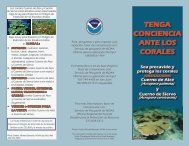Protected Species in the Gulf of Mexico - NMFS' Southeast Region ...
Protected Species in the Gulf of Mexico - NMFS' Southeast Region ...
Protected Species in the Gulf of Mexico - NMFS' Southeast Region ...
You also want an ePaper? Increase the reach of your titles
YUMPU automatically turns print PDFs into web optimized ePapers that Google loves.
An Overview <strong>of</strong> <strong>Protected</strong><br />
<strong>Species</strong> Commonly Found<br />
<strong>in</strong> <strong>the</strong> <strong>Gulf</strong> <strong>of</strong> <strong>Mexico</strong><br />
NOAA Fisheries Service<br />
Sou<strong>the</strong>ast <strong>Region</strong>al Office<br />
<strong>Protected</strong> Resources Division<br />
Revised February 2008
Introduction<br />
NOAA Fisheries Service is responsible<br />
for protect<strong>in</strong>g <strong>the</strong> nation’s liv<strong>in</strong>g<br />
mar<strong>in</strong>e resources and <strong>the</strong>ir habitat.<br />
What are protected species?<br />
PROTECTED SPECIES<br />
Any species under jurisdiction <strong>of</strong><br />
NOAA Fisheries Service that is<br />
protected by ei<strong>the</strong>r <strong>the</strong> Endangered<br />
<strong>Species</strong> Act (ESA) or <strong>the</strong> Mar<strong>in</strong>e<br />
Mammal Protection Act (MMPA). This<br />
<strong>in</strong>cludes threatened and endangered<br />
species, candidate species, and all<br />
mar<strong>in</strong>e mammals.
Def<strong>in</strong>itions<br />
Endangered <strong>Species</strong>: <strong>Species</strong> any species <strong>in</strong> danger<br />
<strong>of</strong> ext<strong>in</strong>ction throughout a significant<br />
portion <strong>of</strong> its range.<br />
Threatened <strong>Species</strong>: <strong>Species</strong> any species likely to<br />
become endangered <strong>in</strong> <strong>the</strong> foreseeable<br />
future throughout a significant portion <strong>of</strong><br />
its range.<br />
Candidate <strong>Species</strong>: <strong>Species</strong> any species be<strong>in</strong>g<br />
considered for list<strong>in</strong>g as threatened or<br />
endangered.<br />
PROTECTED SPECIES<br />
<strong>Species</strong> <strong>of</strong> Concern: Concern any species that NOAA<br />
Fisheries Service has concerns regard<strong>in</strong>g<br />
status and threats.
Def<strong>in</strong>itions<br />
PROTECTED SPECIES<br />
Mar<strong>in</strong>e Mammals: Mammals all mar<strong>in</strong>e mammals are<br />
protected from take (<strong>in</strong>jury or harassment)<br />
under <strong>the</strong> MMPA regardless <strong>of</strong> status.<br />
Threatened and endangered mar<strong>in</strong>e<br />
mammals are protected under both <strong>the</strong> ESA<br />
and MMPA.
<strong>Gulf</strong> <strong>of</strong> <strong>Mexico</strong><br />
There are 28 different species <strong>of</strong> mar<strong>in</strong>e<br />
mammals known to occur <strong>in</strong> <strong>the</strong> <strong>Gulf</strong> <strong>of</strong><br />
<strong>Mexico</strong>. All 28 species are protected under<br />
<strong>the</strong> MMPA and six are also listed as<br />
endangered under <strong>the</strong> ESA (sperm, sei, f<strong>in</strong>,<br />
blue, humpback and North Atlantic right<br />
whales).<br />
Endangered Mar<strong>in</strong>e Mammals<br />
Of <strong>the</strong> six ESA-listed whales, only<br />
endangered sperm whales are considered<br />
to commonly occur. There is a resident<br />
population <strong>of</strong> female sperm whales <strong>in</strong> <strong>the</strong><br />
<strong>Gulf</strong> <strong>of</strong> <strong>Mexico</strong>, and whales with calves are<br />
sighted frequently.<br />
MARINE MAMMALS
Threatened and Endangered Sea Turtles<br />
•<br />
•<br />
•<br />
•<br />
•<br />
Kemp’s ridley sea turtles<br />
Hawksbill sea turtles<br />
Green sea turtles<br />
Loggerhead sea turtles<br />
Lea<strong>the</strong>rback sea turtles<br />
Threatened and Endangered Fish<br />
•<br />
•<br />
<strong>Gulf</strong> <strong>of</strong> <strong>Mexico</strong><br />
<strong>Gulf</strong> sturgeon<br />
Smalltooth sawfish<br />
SEA TURTLES AND FISH
<strong>Gulf</strong> <strong>of</strong> <strong>Mexico</strong><br />
<strong>Species</strong> <strong>of</strong> Concern<br />
• Alabama Shad<br />
• Dusky Shark<br />
• Key silverside<br />
• Largetooth Sawfish<br />
• Mangrove Rivulus<br />
• Nassau Grouper<br />
• Night Shark<br />
SPECIES OF CONCERN<br />
CANDIDATE SPECIES<br />
• Opossum Pipefish<br />
• Saltmarsh<br />
Topm<strong>in</strong>now<br />
• Speckled H<strong>in</strong>d<br />
• Sand Tiger Shark<br />
• Warsaw Grouper<br />
• White Marl<strong>in</strong><br />
Candidate <strong>Species</strong><br />
No candidate species are present <strong>in</strong> <strong>the</strong> <strong>Gulf</strong> <strong>of</strong><br />
<strong>Mexico</strong>
<strong>Gulf</strong> <strong>of</strong> <strong>Mexico</strong><br />
Animals are not randomly<br />
distributed <strong>in</strong> <strong>the</strong> oceans.<br />
<strong>Species</strong> <strong>in</strong>habit areas that<br />
provide life-support<strong>in</strong>g needs<br />
such as shelter, feed<strong>in</strong>g, and<br />
reproduction.<br />
Many species<br />
seasonally migrate or <strong>in</strong>habit<br />
large home ranges to meet<br />
biological needs.<br />
ANIMAL DISTRIBUTION<br />
Sea surface height from satellite data. Sea surface height<br />
can <strong>in</strong>dicate areas <strong>of</strong> upwell<strong>in</strong>g and downwell<strong>in</strong>g.<br />
Oceanic features affect <strong>the</strong> distribution and abundance <strong>of</strong><br />
protected species. Some important features <strong>in</strong>clude<br />
seafloor relief (e.g., shelf edges and canyons), water<br />
temperature, ocean currents (e.g., <strong>the</strong> Loop Current), and<br />
cyclonic and anti-cyclonic eddies.
<strong>Gulf</strong> <strong>of</strong> <strong>Mexico</strong><br />
The cont<strong>in</strong>ental shelf extends<br />
seaward until it reaches a depth<br />
<strong>of</strong> approximately 200m. At <strong>the</strong><br />
edge <strong>of</strong> <strong>the</strong> shelf, <strong>the</strong> seafloor<br />
descends down a slope to much<br />
greater water depths.<br />
CONTINENTAL SHELF<br />
<strong>Protected</strong> species are <strong>of</strong>ten found near oceanographic<br />
features <strong>in</strong> <strong>the</strong> <strong>Gulf</strong> <strong>of</strong> <strong>Mexico</strong>. For example, areas <strong>of</strong><br />
mix<strong>in</strong>g and upwell<strong>in</strong>g near <strong>the</strong> shelf edge, oceanic fronts,<br />
currents, and cyclonic eddies are all areas where many<br />
species f<strong>in</strong>d forag<strong>in</strong>g opportunities or hunt <strong>the</strong>ir<br />
preferred prey.
<strong>Gulf</strong> <strong>of</strong> <strong>Mexico</strong><br />
NEARSHORE and<br />
OFFSHORE SPECIES<br />
The <strong>Gulf</strong> <strong>of</strong> <strong>Mexico</strong> is home to a high<br />
diversity <strong>of</strong> organisms. <strong>Species</strong> may be<br />
generally grouped accord<strong>in</strong>g to water<br />
depths where <strong>the</strong>y most <strong>of</strong>ten occur.<br />
Nearshore = Estuar<strong>in</strong>e waters to<br />
cont<strong>in</strong>ental shelf edge (0m - 200m).<br />
Offshore = Beyond shelf edge (> 200m).<br />
Nearshore and <strong>of</strong>fshore occurrences are<br />
approximations <strong>of</strong> distribution, and many<br />
species <strong>in</strong> <strong>the</strong> <strong>Gulf</strong> <strong>of</strong> <strong>Mexico</strong> may migrate<br />
between <strong>the</strong>se areas dur<strong>in</strong>g <strong>the</strong>ir life cycle<br />
or seasonally (e.g., for reproduction, water<br />
temperature, currents, and prey<br />
availability).
NEARSHORE SPECIES
Nearshore <strong>Species</strong><br />
MARINE MAMMALS<br />
Typically, no threatened or endangered species <strong>of</strong><br />
whales<br />
occur <strong>in</strong> <strong>the</strong> nearshore waters<br />
over <strong>the</strong><br />
cont<strong>in</strong>ental shelf <strong>of</strong> <strong>the</strong> <strong>Gulf</strong> <strong>of</strong> <strong>Mexico</strong>.<br />
Occasionally, North Atlantic right whales and<br />
humpback whales may be found <strong>in</strong> nearshore waters <strong>of</strong><br />
<strong>the</strong> <strong>Gulf</strong> <strong>of</strong> <strong>Mexico</strong>, usually dur<strong>in</strong>g <strong>the</strong> w<strong>in</strong>ter season.<br />
However, sight<strong>in</strong>gs <strong>of</strong> <strong>the</strong>se species are relatively<br />
uncommon.<br />
Of <strong>the</strong> 28 species <strong>of</strong> mar<strong>in</strong>e mammals known to occur<br />
<strong>in</strong> <strong>the</strong> <strong>Gulf</strong> <strong>of</strong> <strong>Mexico</strong>, only three protected species <strong>of</strong><br />
dolph<strong>in</strong>s commonly occur <strong>in</strong> nearshore waters. waters
Common Nearshore <strong>Species</strong><br />
Dolph<strong>in</strong> Ecology Project<br />
DOLPHINS<br />
Bottlenose dolph<strong>in</strong>s <strong>in</strong>habit <strong>the</strong> <strong>Gulf</strong> <strong>of</strong> <strong>Mexico</strong> yearround.<br />
They are blue-gray with lighter sides and<br />
bellies and have a robust body and head. This species<br />
is <strong>the</strong> most commonly observed dolph<strong>in</strong> <strong>in</strong> nearshore<br />
waters, and travel alone or <strong>in</strong> groups up to 20.<br />
Atlantic spotted dolph<strong>in</strong>s prefer tropical to warmtemperate<br />
waters over <strong>the</strong> cont<strong>in</strong>ental shelf, edge, and<br />
upper reaches <strong>of</strong> <strong>the</strong> slope. These dolph<strong>in</strong>s have<br />
variable spott<strong>in</strong>g. They are very active at <strong>the</strong> surface<br />
and <strong>of</strong>ten breach while feed<strong>in</strong>g. Group size is usually<br />
between 5-15.<br />
Risso’s dolph<strong>in</strong>s are typically found around <strong>the</strong><br />
cont<strong>in</strong>ental shelf edge and steep upper sections <strong>of</strong> <strong>the</strong><br />
slope (>100 m depths). They are light gray and <strong>of</strong>ten<br />
exhibit extensive scarr<strong>in</strong>g. These dolph<strong>in</strong>s travel alone<br />
or <strong>in</strong> groups <strong>of</strong> >100, and may be observed with o<strong>the</strong>r<br />
species.
Endangered and Threatened<br />
Nearshore <strong>Species</strong><br />
Loggerhead Green Kemp’s ridely Hawksbill<br />
threatened threatened; Florida<br />
nest<strong>in</strong>g population is<br />
endangered<br />
endangered<br />
SEA TURTLES<br />
endangered<br />
Sea turtles may be observed breath<strong>in</strong>g, bask<strong>in</strong>g, swimm<strong>in</strong>g,<br />
or feed<strong>in</strong>g at <strong>the</strong> surface. Sea turtles may migrate long<br />
distances and are able to dive to great depths.<br />
Lea<strong>the</strong>rback sea turtles (not pictured above) typically<br />
<strong>in</strong>habit pelagic waters, but can also be found <strong>in</strong> nearshore<br />
waters dur<strong>in</strong>g <strong>the</strong> nest<strong>in</strong>g season while feed<strong>in</strong>g on jellyfish<br />
concentrations, or <strong>in</strong> deep nearshore waters.<br />
Cat Holloway
Endangered and Threatened<br />
Nearshore <strong>Species</strong><br />
Nest<strong>in</strong>g Kemp’s ridley sea turtle<br />
NPS Photo, Cynthia Rubio<br />
Nest<strong>in</strong>g:<br />
SEA TURTLES<br />
between May and October,<br />
Nests: several clutches (groups <strong>of</strong><br />
eggs) each nest<strong>in</strong>g season.<br />
Eggs: Between 50-70 p<strong>in</strong>g-pong ballsized<br />
eggs are deposited <strong>in</strong> a nest<br />
cavity and buried with sand.<br />
Hatch<strong>in</strong>g: Eggs hatch after 8-10<br />
weeks <strong>of</strong> <strong>in</strong>cubation.<br />
Females return to lay eggs on <strong>the</strong> beach from which <strong>the</strong>y hatched<br />
and swam <strong>of</strong>fshore as hatchl<strong>in</strong>gs.<br />
Generally, sea turtles are found <strong>in</strong> higher abundances <strong>in</strong><br />
nearshore coastal waters <strong>of</strong>f nest<strong>in</strong>g beaches and forag<strong>in</strong>g areas.<br />
Nearshore coastal areas are also important forag<strong>in</strong>g habitats for<br />
juvenile sea turtles.
Endangered Nearshore <strong>Species</strong><br />
SMALLTOOTH<br />
SAWFISH<br />
The endangered smalltooth sawfish<br />
<strong>in</strong>habits coastal areas near mangroves<br />
and estuaries. Larger animals may be<br />
found fur<strong>the</strong>r <strong>of</strong>fshore. Sawfish have<br />
a long, flat snout edged with pairs <strong>of</strong><br />
teeth used to locate, stun, and kill<br />
prey. They swim <strong>in</strong>to schools <strong>of</strong> fish<br />
and thrash <strong>the</strong>ir saw from side to side,<br />
wound<strong>in</strong>g and kill<strong>in</strong>g <strong>the</strong> fish which<br />
<strong>the</strong>y <strong>the</strong>n recover and eat. Smalltooth<br />
sawfish usually grow to about 18 feet<br />
<strong>in</strong> length and are related to sharks,<br />
skates, and rays.
Threatened Nearshore <strong>Species</strong><br />
GULF STURGEON<br />
The <strong>Gulf</strong> sturgeon is a<br />
threatened species. This species<br />
represents one <strong>of</strong> <strong>the</strong> oldest<br />
l<strong>in</strong>eages <strong>of</strong> liv<strong>in</strong>g fish. They are<br />
an anadromous fish that<br />
migrates from mar<strong>in</strong>e habitats<br />
<strong>in</strong>to freshwater rivers to<br />
spawn. They reside <strong>in</strong> rivers<br />
dur<strong>in</strong>g summer and <strong>in</strong> mar<strong>in</strong>e<br />
environments dur<strong>in</strong>g w<strong>in</strong>ter.<br />
<strong>Gulf</strong> sturgeon have rows <strong>of</strong> armored plates along <strong>the</strong>ir sides and<br />
back, called scutes, and a vacuum-like mouth to forage on benthic<br />
<strong>in</strong>vertebrates. Sturgeon are light colored to dark brown and have<br />
a white under-belly. They can grow to 8 feet <strong>in</strong> length and weigh<br />
200 pounds.
Threatened Nearshore <strong>Species</strong><br />
Areas shaded yellow are designated as <strong>Gulf</strong><br />
sturgeon critical habitat.<br />
GULF STURGEON<br />
The Endangered <strong>Species</strong> Act<br />
(ESA) requires <strong>the</strong> federal<br />
government to evaluate any<br />
potential critical habitat that<br />
exists for a species. Critical<br />
habitat is an area deemed<br />
essential to <strong>the</strong> conservation <strong>of</strong> a<br />
species.<br />
For <strong>Gulf</strong> sturgeon many coastal<br />
waters east <strong>of</strong> <strong>the</strong> mouth <strong>of</strong> <strong>the</strong><br />
Mississippi to <strong>the</strong> Suwannee<br />
River <strong>in</strong> Florida are designated<br />
critical habitat.
Threatened<br />
Nearshore <strong>Species</strong><br />
ELKHORN and<br />
STAGHORN CORALS<br />
Elkhorn (Acropora palmata) and staghorn (A. cervicornis) corals are<br />
threatened species. These stony corals were once <strong>the</strong> most abundant<br />
and most important species on Caribbean coral reefs.<br />
Elkhorn coral is <strong>the</strong> largest <strong>of</strong> all species <strong>of</strong><br />
Acropora. Colonies are flattened to near round<br />
with frond-like branches. Branches typically<br />
radiate outward from a central trunk. Elkhorn<br />
coral generally grows <strong>in</strong> water 3 to 15 feet deep<br />
on <strong>the</strong> seaward face <strong>of</strong> <strong>the</strong> reef.<br />
Staghorn coral colonies are antler-like with<br />
cyl<strong>in</strong>drical, straight, or slightly curved<br />
branches. Staghorn coral typically grows <strong>in</strong><br />
foreand back-reef areas with water 15 to 45<br />
feet deep.
Nearshore <strong>Species</strong> <strong>of</strong> Concern<br />
Sand tiger sharks<br />
SHARKS<br />
are a species <strong>of</strong> concern. concern They are light<br />
grey/brown <strong>in</strong> color and have a white belly with yellow blotches.<br />
They have two dorsal f<strong>in</strong>s <strong>of</strong> similar size, a very short snout, and<br />
small eyes. They generally occupy <strong>the</strong> surf zone down to depths <strong>of</strong><br />
about 25m. However, <strong>the</strong>y may also be found <strong>in</strong> shallow bays,<br />
around coral reefs, and to depths <strong>of</strong> 200m on <strong>the</strong> cont<strong>in</strong>ental shelf.<br />
They usually live near <strong>the</strong> bottom, but have been found throughout<br />
<strong>the</strong> water column. These sharks are primarily active at night, and<br />
travel alone or <strong>in</strong> small schools.
Nearshore <strong>Species</strong> <strong>of</strong> Concern<br />
GROUPER<br />
is a species <strong>of</strong><br />
The Nassau grouper<br />
concern and can be found <strong>in</strong> coastal<br />
waters to depths <strong>of</strong> about 100m.<br />
Adults are generally found near<br />
shallow high-relief coral reefs and<br />
rocky bottoms to a depth <strong>of</strong> at least<br />
90m. Juveniles are known to <strong>in</strong>habit<br />
seagrass beds and areas around coral<br />
clumps covered with macroalgae.<br />
Nassau grouper are characterized by<br />
5 dark brown vertical bars on a pale<br />
tan or gray body with black spots<br />
around <strong>the</strong> eyes.
Nearshore <strong>Species</strong> <strong>of</strong> Concern<br />
ALABAMA GROUPER SHAD<br />
The Alabama shad is a species <strong>of</strong> concern. concern It is a euryhal<strong>in</strong>e, anadromous<br />
species that spawns <strong>in</strong> medium to large flow<strong>in</strong>g rivers from <strong>the</strong><br />
Mississippi River dra<strong>in</strong>age to <strong>the</strong> Suwannee River, Florida.<br />
Diagnostic characters <strong>of</strong> <strong>the</strong> Alabama shad are <strong>the</strong>ir upper jaw with a<br />
dist<strong>in</strong>ct median notch, and <strong>the</strong> number <strong>of</strong> gill rakers on <strong>the</strong> lower limb<br />
<strong>of</strong> <strong>the</strong> anterior gill arch (41-48). Alabama shad differ from o<strong>the</strong>r<br />
members <strong>of</strong> <strong>the</strong>ir family <strong>in</strong> <strong>the</strong> same area <strong>in</strong> that <strong>the</strong> lower jaw does<br />
not protrude beyond <strong>the</strong> upper jaw, black spots are present along <strong>the</strong><br />
length <strong>of</strong> <strong>the</strong> lower jaw, and <strong>the</strong> dorsal f<strong>in</strong> lacks an elongate filament.
Nearshore <strong>Species</strong> <strong>of</strong> Concern<br />
The Largetooth sawfish, a species <strong>of</strong><br />
concern, is generally a tropical mar<strong>in</strong>e and<br />
estuar<strong>in</strong>e elasmobranch. All modern<br />
sawfishes appear <strong>in</strong> some respects to be<br />
more shark-like than ray-like, with only<br />
<strong>the</strong> trunk and especially <strong>the</strong> head ventrally<br />
flattened. The presence <strong>of</strong> a rostrum<br />
hav<strong>in</strong>g laterally protrud<strong>in</strong>g teeth separates<br />
sawfishes from all o<strong>the</strong>r skates and rays.<br />
Historical occurrences <strong>of</strong> largetooth<br />
sawfish <strong>in</strong> North America were much more<br />
limited than those <strong>of</strong> <strong>the</strong> related<br />
smalltooth sawfish and were strictly<br />
conf<strong>in</strong>ed to shallow (< 33 feet or 10 m),<br />
near-shore, warm-temperate and tropical<br />
waters (>64-86 oF; 18-30oC), estuar<strong>in</strong>e<br />
localities, partly enclosed lagoons, and<br />
similar situations.<br />
LARGETOOTH<br />
SAWFISH
Nearshore <strong>Species</strong> <strong>of</strong> Concern<br />
SALTMARSH<br />
TOPMINNOW<br />
The saltmarsh topm<strong>in</strong>now is a species <strong>of</strong> concern and is<br />
endemic to brackish water areas from Galveston Bay, Texas to<br />
Escambia Bay <strong>in</strong> <strong>the</strong> western panhandle <strong>of</strong> Florida.<br />
It is one <strong>of</strong> <strong>the</strong> smallest members <strong>of</strong> <strong>the</strong> topm<strong>in</strong>now/killifish family<br />
(Fundulidae), seldom exceed<strong>in</strong>g 1.75 <strong>in</strong>ches.<br />
They have little color <strong>in</strong> life; <strong>the</strong>re is cross-hatch<strong>in</strong>g on <strong>the</strong> back<br />
and sides that may be gray-green or fa<strong>in</strong>ter and 12 to 30 dark<br />
round spots are <strong>of</strong>ten arranged <strong>in</strong> rows along <strong>the</strong> midside <strong>of</strong> <strong>the</strong><br />
body from above <strong>the</strong> pectoral f<strong>in</strong> to <strong>the</strong> base <strong>of</strong> <strong>the</strong> caudal f<strong>in</strong>.
Nearshore <strong>Species</strong> <strong>of</strong> Concern<br />
KEY SILVERSIDE<br />
The Key silverside, a species <strong>of</strong> concern, has a restricted<br />
distribution and is only found <strong>in</strong> <strong>the</strong> Florida Keys, from Key West<br />
north to Long Key.<br />
The ma<strong>in</strong> habitat <strong>of</strong> Key silversides is tidal creek, lagoon, and<br />
pond waters <strong>of</strong> vary<strong>in</strong>g sal<strong>in</strong>ity (NatureServe<br />
2006). Florida<br />
considers <strong>the</strong>m members <strong>of</strong> <strong>the</strong> mangrove, pelagic, and subtidal<br />
unconsolidated mar<strong>in</strong>e/estuary sediment habitats.<br />
The key silverside is <strong>the</strong> smallest known species <strong>of</strong> Menidia; its<br />
maximum size is about 2 <strong>in</strong>ches (53 mm).
Nearshore <strong>Species</strong> <strong>of</strong> Concern<br />
OPOSSUM<br />
PIPEFISH<br />
Opossum pipefish are a species<br />
<strong>of</strong> concern and are a widespread<br />
species that spawn <strong>in</strong> low sal<strong>in</strong>ity<br />
areas <strong>of</strong> estuaries.<br />
Year round captures <strong>in</strong>dicat<strong>in</strong>g<br />
permanent populations only occur<br />
<strong>in</strong> sou<strong>the</strong>astern Florida tributaries<br />
<strong>in</strong> <strong>the</strong> U.S., most notably <strong>in</strong> <strong>the</strong><br />
Indian River Lagoon.<br />
The color <strong>of</strong> <strong>the</strong> opossum pipefish<br />
is dist<strong>in</strong>ctive, especially <strong>in</strong><br />
breed<strong>in</strong>g adults, as seen <strong>in</strong> <strong>the</strong><br />
picture.
Nearshore <strong>Species</strong> <strong>of</strong> Concern<br />
MANGROVE<br />
RIVULUS<br />
The mangrove rivulus, a species <strong>of</strong> concern, has a long slender,<br />
dorsally flattened body and a rounded caudal f<strong>in</strong>. It is dark brown to<br />
green <strong>in</strong> coloration. The body may be mottled with small black dots<br />
and <strong>the</strong>re may be a little orange coloration on body and f<strong>in</strong>s.<br />
The mangrove rivulus<br />
can be found from south-central Florida (where<br />
it is a species <strong>of</strong> concern) south through <strong>the</strong> West Indies to coastal<br />
areas <strong>of</strong> South America. It can also be found throughout <strong>the</strong> waters <strong>of</strong><br />
Cuba, <strong>the</strong> Bahamas, Jamaica, and <strong>the</strong> Yucatan Pen<strong>in</strong>sula.<br />
Mangrove rivulus is one <strong>of</strong> a few known self-fertiliz<strong>in</strong>g<br />
hermaphrodites. They can also live out <strong>of</strong> water for up to 66 days.
OFFSHORE SPECIES
Endangered Offshore <strong>Species</strong><br />
SEA TURTLES<br />
The endangered lea<strong>the</strong>rback sea turtle<br />
is <strong>the</strong> only sea turtle with a s<strong>of</strong>t<br />
lea<strong>the</strong>ry shell. They are <strong>the</strong> largest <strong>of</strong><br />
<strong>the</strong> sea turtles, measur<strong>in</strong>g 4 to 8 feet<br />
long and weigh<strong>in</strong>g 650 to 1,300<br />
pounds. They can dive to great<br />
depths <strong>in</strong> search <strong>of</strong> jellyfish, which<br />
comprise <strong>the</strong>ir ma<strong>in</strong> diet.<br />
Lea<strong>the</strong>rbacks make long-distance migrations from feed<strong>in</strong>g<br />
grounds to nest<strong>in</strong>g beaches. They spend <strong>the</strong>ir entire lives <strong>in</strong><br />
<strong>of</strong>fshore waters, com<strong>in</strong>g <strong>in</strong>shore only to mate and nest. They are<br />
<strong>of</strong>ten observed alone at sea, but adults sometimes congregate <strong>of</strong>f<br />
nest<strong>in</strong>g beaches or while feed<strong>in</strong>g on concentrations <strong>of</strong> prey.
Endangered Offshore <strong>Species</strong><br />
Sperm whales<br />
SPERM WHALE<br />
are endangered and found<br />
<strong>in</strong> <strong>of</strong>fshore waters <strong>of</strong> <strong>the</strong> <strong>Gulf</strong> <strong>of</strong> <strong>Mexico</strong><br />
(>200m). They typically dive deep for 40-<br />
45 m<strong>in</strong>utes and rest at <strong>the</strong> surface for 8-<br />
10 m<strong>in</strong>utes between dives. Their squareshaped<br />
head comprises a significant<br />
portion <strong>of</strong> <strong>the</strong>ir body length and <strong>the</strong>y<br />
have a small dorsal f<strong>in</strong>. Sperm whales<br />
are <strong>of</strong>ten seen rest<strong>in</strong>g log-like at <strong>the</strong><br />
surface. Females and young form small<br />
groups, and immature males <strong>of</strong>ten form<br />
bachelor groups.
Common Offshore <strong>Species</strong><br />
WHALES<br />
Cuvier’s beaked whales are elusive and<br />
rarely seen at <strong>the</strong> surface, which is why<br />
<strong>the</strong>ir population status is unknown.<br />
These whales vary <strong>in</strong> coloration from<br />
rusty-brown, dark gray, or tan. They<br />
prefer deep water, avoid shallow coastal<br />
areas, and are known to travel <strong>in</strong> groups<br />
<strong>of</strong> 2 to 7.<br />
Bryde’s whales (pronounced “BREW-days”) are<br />
perhaps <strong>the</strong> only baleen whale that regularly<br />
<strong>in</strong>habit <strong>the</strong> <strong>Gulf</strong> <strong>of</strong> <strong>Mexico</strong>. This species has<br />
been regularly sighted <strong>in</strong> <strong>the</strong> nor<strong>the</strong>astern <strong>Gulf</strong><br />
<strong>of</strong> <strong>Mexico</strong> and may be found elsewhere seaward<br />
<strong>of</strong> <strong>the</strong> shelf edge. They have dark gray, slender<br />
bodies and long ventral throat grooves. They<br />
travel alone or <strong>in</strong> small groups.
Common Offshore <strong>Species</strong><br />
DOLPHINS<br />
Pantropical spotted dolph<strong>in</strong>s occur along <strong>the</strong><br />
cont<strong>in</strong>ental slope. Juveniles are gray, spott<strong>in</strong>g as<br />
<strong>the</strong>y age. These dolph<strong>in</strong>s are extremely active,<br />
frequently breach<strong>in</strong>g <strong>the</strong> surface as <strong>the</strong>y travel.<br />
Group sizes range from a few to 1000s.<br />
Rough-too<strong>the</strong>d dolph<strong>in</strong>s are deep-water<br />
dolph<strong>in</strong>s. They have cone-shaped heads and<br />
large po<strong>in</strong>ted flippers. These dolph<strong>in</strong>s are fast<br />
swimmers and sometimes breach with a low, arcshape<br />
at <strong>the</strong> surface. They travel <strong>in</strong> groups <strong>of</strong><br />
10s to 100s.<br />
Clymene dolph<strong>in</strong>s are found seaward <strong>of</strong> <strong>the</strong><br />
cont<strong>in</strong>ental shelf edge. They are tri-colored with a<br />
dark gray back, gray sides, and a white belly. They<br />
are <strong>of</strong>ten observed <strong>in</strong> groups <strong>of</strong> up to 50. They are<br />
frequently observed mak<strong>in</strong>g full sp<strong>in</strong>s when<br />
breach<strong>in</strong>g at <strong>the</strong> surface.
Offshore <strong>Species</strong><br />
• pygmy sperm whale<br />
• dwarf sperm whale<br />
• melon-headed whale<br />
• pygmy killer whale<br />
• false killer whale<br />
• short-f<strong>in</strong>ned pilot<br />
whale<br />
• Fraser’s dolph<strong>in</strong><br />
• Atlantic spotted<br />
dolph<strong>in</strong><br />
• sp<strong>in</strong>ner dolph<strong>in</strong><br />
• striped dolph<strong>in</strong><br />
• bottlenose dolph<strong>in</strong><br />
• killer whale (orca)<br />
• Bla<strong>in</strong>ville’s beaked<br />
whale<br />
• Sowerby’s beaked<br />
whale<br />
• Gervais’<br />
MARINE MAMMALS<br />
O<strong>the</strong>r Offshore <strong>Species</strong> <strong>of</strong> Mar<strong>in</strong>e Mammals In The<br />
<strong>Gulf</strong> Of <strong>Mexico</strong> Include…<br />
• m<strong>in</strong>ke whale<br />
beaked whale
O<strong>the</strong>r <strong>Species</strong> <strong>of</strong> Concern<br />
Dusky sharks<br />
Night sharks<br />
SHARKS<br />
are a species <strong>of</strong> concern and<br />
can be found from <strong>the</strong> surf zone to <strong>of</strong>fshore<br />
depths <strong>of</strong> about 400m. These sharks are<br />
bluish gray with white on <strong>the</strong> belly. They<br />
have a long po<strong>in</strong>ted snout, long pectoral<br />
f<strong>in</strong>s, and a low ridge between <strong>the</strong> dorsal<br />
f<strong>in</strong>s. Juvenile dusky sharks form large<br />
feed<strong>in</strong>g schools or aggregations.<br />
are a species <strong>of</strong> concern and<br />
are typically found near <strong>the</strong> cont<strong>in</strong>ental<br />
shelf edge <strong>in</strong> depths between 275m and<br />
365m dur<strong>in</strong>g <strong>the</strong> day, and 185m at night.<br />
They have a very long, po<strong>in</strong>ted snout, large<br />
green eyes, and two small dorsal f<strong>in</strong>s.<br />
They are usually observed travel<strong>in</strong>g <strong>in</strong><br />
schools.
O<strong>the</strong>r <strong>Species</strong> <strong>of</strong> Concern<br />
Warsaw groupers<br />
are a species <strong>of</strong> concern.<br />
They are deep-water groupers that <strong>in</strong>habit<br />
reefs on <strong>the</strong> cont<strong>in</strong>ental shelf break, <strong>in</strong><br />
waters 76-219m deep. Color varies from<br />
reddish brown or brownish grey to almost<br />
black, with dull reddish grey on <strong>the</strong> belly.<br />
Mature animals are usually found on<br />
rough, rocky bottoms <strong>in</strong> depths <strong>of</strong> 55 to<br />
525m; juveniles are occasionally seen on<br />
jetties and shallow-water reefs.<br />
The speckled h<strong>in</strong>d<br />
GROUPER<br />
is a species <strong>of</strong> concern and<br />
is classified as a deep-water grouper: adults<br />
<strong>in</strong>habit <strong>of</strong>fshore rocky bottoms usually <strong>in</strong><br />
depths <strong>of</strong> 60 and 120m. Their reddish-brown<br />
head, body, and f<strong>in</strong>s are flecked with t<strong>in</strong>y<br />
white spots.
O<strong>the</strong>r <strong>Species</strong> <strong>of</strong> Concern<br />
WHITE MARLIN<br />
White marl<strong>in</strong>, a species <strong>of</strong> concern,<br />
are large, elongated fish with a large<br />
upper jaw that forms a spear which<br />
is round <strong>in</strong> cross-section.<br />
They are dark blue to chocolatebrown<br />
<strong>in</strong> color dorsally, brownishsilvery-white<br />
laterally, and silvery<br />
white ventrally. White marl<strong>in</strong> are<br />
found <strong>in</strong> <strong>of</strong>fshore waters throughout<br />
<strong>the</strong> tropical and temperate Atlantic<br />
Ocean and adjacent seas and are<br />
considered species <strong>of</strong> concern <strong>in</strong> <strong>the</strong><br />
Western Atlantic.
<strong>Gulf</strong> <strong>of</strong> <strong>Mexico</strong><br />
PROTECTED SPECIES<br />
<strong>Protected</strong> species <strong>in</strong>habit nearly all<br />
mar<strong>in</strong>e environments from <strong>the</strong><br />
shallow waters <strong>of</strong> estuaries to <strong>the</strong><br />
deep ocean. Because many<br />
human activities occur <strong>in</strong> <strong>the</strong>se<br />
same areas, it is important that<br />
each <strong>of</strong> us remembers to always be<br />
an active steward <strong>of</strong> <strong>the</strong> mar<strong>in</strong>e<br />
environment and help protect our<br />
liv<strong>in</strong>g mar<strong>in</strong>e resources.<br />
Through science and conservation<br />
programs with our partners, NOAA<br />
Fisheries Service cont<strong>in</strong>ues to<br />
ma<strong>in</strong>ta<strong>in</strong> susta<strong>in</strong>able populations<br />
and protect <strong>the</strong> ecosystems upon<br />
which <strong>the</strong>se species depend.
For a complete list <strong>of</strong> protected species <strong>in</strong><br />
<strong>the</strong> <strong>Gulf</strong> <strong>of</strong> <strong>Mexico</strong> and additional<br />
<strong>in</strong>formation about <strong>the</strong>se species, please<br />
visit <strong>the</strong> NMFS Sou<strong>the</strong>ast <strong>Region</strong>al Office<br />
Web site at:<br />
http://sero.nmfs.noaa.gov/pr/protres.htm<br />
or<br />
http://www.nmfs.noaa.gov/pr


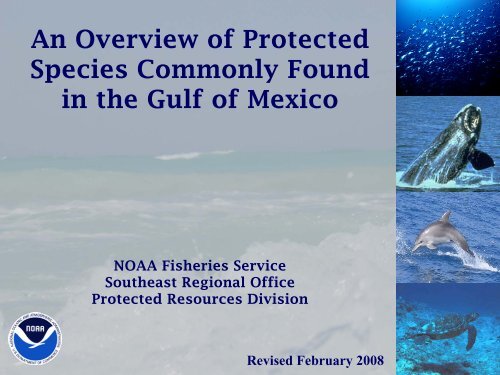
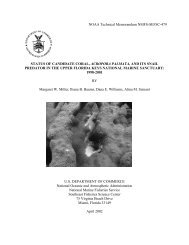
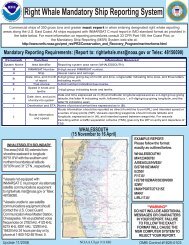


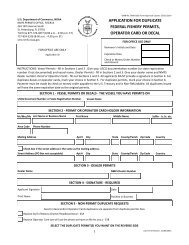
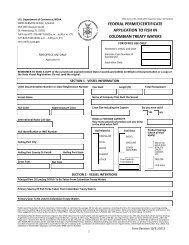
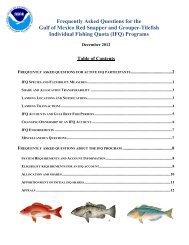

![Right Whale Fact Sheet [PDF] - Southeast Regional Office - NOAA](https://img.yumpu.com/28432664/1/190x245/right-whale-fact-sheet-pdf-southeast-regional-office-noaa.jpg?quality=85)

